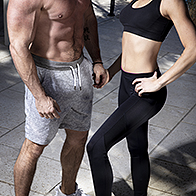How to Start a New Workout Program Safely

If you're getting back into working out after a long break or you've never adopted a workout program before and don't know where to start, it's important to begin with appropriate safety measures.
Start off by reviewing some basics.
- Start with what you can manage. "If you're starting weight training, pick a weight you can comfortably lift for 10 reps. The last 2 to 3 reps should be really challenging," said Sridhar Yalamanchili, a physical therapist with Atlantic Spine Center in New Jersey.
- Maintain intensity. Yalamanchili recommends maintaining intensity by figuring out the right duration (probably 30 to 45 minutes per workout) or number of reps. Conditioning your body for exercise will help ensure long-term commitment.
- Stay away from exercises that cause pain or injury. This is even more important if you have an existing injury. If you're hoping to exercise to recover from an injury or health problem, consult your doctor or physical therapist first.
- Practice correct form. Doing a workout once with the correct form is better than doing it 100 times incorrectly. This will yield better-desired results long-term and help to prevent injury.
- Warm up and cool down. "Just like you wouldn't start up a car that's been parked all winter long and zoom down the driveway before giving it time to warm up, the same goes for your body," said Bert Mandelbaum, M.D., sports medicine specialist and orthopedic surgeon at Cedars-Sinai Kerlan-Jobe Institute. "We need a few minutes of warm-up time before any physical activity to get the blood flowing and give the muscles and joints a heads-up that they're about to be put to work. Cold muscles are much less flexible and much more prone to injury."
Be mindful of pain
"There are no specific activities to avoid based on prior injuries," said Siddharth Tambar, a board-certified rheumatologist with Chicago Arthritis and Regenerative Medicine. "Rather, base it on whether the exercise exacerbates pain. If so, then back off."
For example, Tambar said, if you have a history of knee injuries, running may be okay, assuming it doesn't cause pain. For lower back and neck injuries, if you are doing weight lifting that causes stress on the back, as long as you are not experiencing pangs or suffering any neurologic symptoms in the arms or legs (numbness, tingling, pain), you are probably clear to proceed.
Yalamanchili noted people with previous injuries to the neck and back may commence light weight training after achieving pain-free spinal motion, following treatment plans from their respective healthcare providers.
"Using gym machines before free weights may help build confidence," Yalamanchili said.
"When in doubt, speak with your physician," Tambar echoed.
Best beginner workouts for almost anyone
Diving into a workout program can be intimidating if you're an exercise neophyte. Luckily, there are plenty of guides out there to tell you what to do, how to do it and when to do it.
Tambar noted workout recommendations depend on the individual's needs and desires, their injury history, other medical issues and their baseline activity level.
"As a good rule of thumb, start activity at 50 percent of what your max level feels like and slowly increase as tolerated," Tambar said.
In terms of the type of workout for beginners, Yalamanchili and Tambar both recommend the following:
- Bodyweight exercises: "Bodyweight-based training helps prepare for the intensity and the load of resistance training (using weights, bands, and so on). For this reason, it is a good way to commence working out to increase strength and build muscle," Yalamanchili said.
- Interval training: Yalamanchili said this could be a simple walking routine, alternating cycles of walking as briskly as you can followed by a slower pace of walking (without stopping to rest). If you walk for 20 minutes, the intervals could be one minute each for the brisk and slower-paced walking; the length of the interval can be adjusted if needed.
- HIIT: An acronym for high-intensity interval training, this marks an escalation in pace from slower interval training. Yalamanchili said these exercises include a 5- to 10-minute cardio workout followed by bodyweight exercises, such as squats, lunges, pushups and press-ups, all to be performed for 30 to 40 seconds, with rest periods of the same length in between. Repeat 3 to 5 rounds of these, followed by stretching. Though exciting, these workouts are typically intended for people with experience, so don't rush into a HIIT class and expect to keep up with the Joneses before you're ready, as that could cause injury.
- Cycling: Cycling is a great first-time option for most people, Tambar said. It's an outstanding aerobic activity that's generally easy on the joints and great for leg strengthening, and the difficulty is easily increased or decreased for your individual tolerance level.
- Water exercises: If you have access to a pool, walking in a pool or doing aqua aerobics is a great low-impact workout, according to Yalamanchili.
Maintaining your workout routine
Sticking with a workout routine is often more difficult than starting one, but there are ways to ensure you'll stick with your new habit.
"Besides being good for your health, your exercise should be enjoyable," Tambar said. "If not, the chances of continuing over the long-term are less likely. Aim to make small gains every day. Your improvement should be a lifelong goal, so stay persistent and consistent with your goal."
'Don't forget those simple things, like walking the dog, raking leaves or taking the stairs instead of the elevator, all count as exercise.'
Mandelbaum noted it is much more beneficial for your body to exercise for 30 minutes daily than to cram it all in over the weekend. Being able to maintain exercise comes down to time and exercise of choice.
"Don't forget those simple things, like walking the dog, raking leaves or taking the stairs instead of the elevator, all count as exercise. If you just don't have time for 30 minutes all together, break it up into two 15-minute sets a day," Mandelbaum said. "Getting some sort of daily exercise is healthier on your body than pulling a 'weekend warrior,' reduces the risk of injury and will also make it possible to actually improve your fitness level as you build it up more every day."
Listen to your body
It is important to trust your body. Tambar explained that if an exercise causes pain or anything else that doesn't feel right, either stop that exercise or reduce intensity. You can't work out long-term if you suffer frequent injuries or ones with lengthy recoveries.
"Whether you're new to exercise or not, please remember pain is not always gain," Mandelbaum said. "Yes, there may be some level of difficulty as you build up your stamina and strength, but pain is never a good thing, and you can get fit without pushing yourself to the point of hurting. If you do feel pain, it may be an injury, so the best bet is to stop exercising, take the rest of the day off and revisit how you feel the following day."
If you're still off in the days following the initial pang, check in with your doctor and discuss possible issues. Go at your own pace when exercising. Rome wasn't built in a day, and neither is a workout habit, so take it easy, trust your body and stay active while adjusting to your new routine.




















